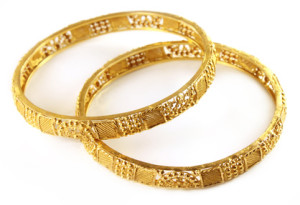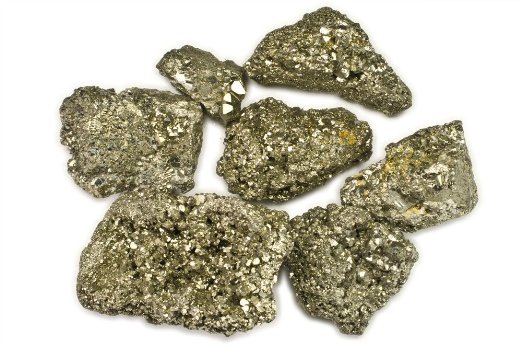How Much Gold Does 18-Karat Jewelry Contain?
Gold karat is a measure of how much of the precious metal is contained in a piece made with it.
If a jewelry item is 18 karats, this simply means that out of a total of 24 parts, 18 parts of the piece are gold, and 6 parts are made up of other metals.

Gold bracelets
Expressed in percentage terms, 18 karats is equal to 75% gold content (18 divided by 24). The other 25% usually consists of metals such as zinc, copper, nickel, etc.
The additional metals in 18K gold serve to make the alloy harder and more durable than pure gold (24K), which is too soft for jewelry.
Pros and Cons: 18K Gold vs. 10K and 14K Gold
Compared with lower karat gold, 18K jewelry has some distinct advantages.
For example, since it is purer, it is less likely to cause an allergic reaction in people sensitive to nickel, if this metal is present in the alloy.
A 10K gold piece that contains nickel, on the other hand, is more likely to give you a rash if you are allergic to the metal.
Another upside to buying 18K gold is that its color is closer to that of pure gold, while the yellow in 10K or 14K jewelry may not be as intense.
By the way, buying 10-karat jewelry, which contains 41.7% gold, means that you will be getting a piece that is made up mostly of metals other than gold.
The downside of 18K gold is that it is softer and less durable than less pure alloys. For example, a 10K or 14K gold ring will wear down more slowly than an 18K piece, which will scratch and bend more easily.
18K vs. 22K Gold
Gold with a karat number higher than 18K is even purer and has a more intense color, but this also comes at a price. 22K gold, for example, is much softer and scratches even more easily than 18K pieces; it is also more expensive.
So, think twice before going for higher karats, especially if you will be wearing the jewelry often.
How to Identify 18K Gold Jewelry
Recognizing 18-karat jewelry is pretty straightforward (as long as the piece has been stamped with its karat number). Usually, you will see a stamp on the item such as 18K, 18Kt, 18ct, 18k, or a similar variation.
Sometimes, 18K gold will be marked with a number such as 750, 0.75, or a similar stamp denoting that the jewelry contains 75% gold (or 750 parts per thousand).
What Percentage of 18-Karat Gold Is Silver?
18-Karat Yellow Gold and Silver Content
The yellow gold alloy used in jewelry is usually made by mixing pure gold with copper and silver.
Nickel can also be used, but many jewelry makers avoid it because it can cause skin allergies in some people.
Usually, the silver content in 18K yellow gold can vary between 10% and 13%.
A typical 18-karat yellow gold alloy contains the following metals: 75% gold, 12.5% copper, and 12.5% silver.
Another common 18-karat alloy contains the same metals in the following proportions: 75% gold, 15% copper, and 10% silver.
You should keep in mind that the proportions of non-gold metals in 18K gold are not set in stone and may vary from one producer to another.
However, the silver content of such an alloy is most likely to be in the 10-12% range.
Silver Content in 18K White Gold
White gold is made by covering a yellow gold alloy with rhodium, which makes the piece’s surface look white and shiny.
An 18-karat white gold alloy also contains 75% gold, but the makeup of the rest is slightly different.
18K gold may contain nickel, manganese, or palladium, which make the resulting alloy look whiter than a yellow gold mixture.
Other metals that 18K gold can contain are zinc and platinum.
A common white gold alloy contains 75% gold, 2.5% silver, 8% nickel, 10% copper, and 4.5% zinc.
However, the non-gold metals and their proportions can vary widely, so the above example should not be taken as a benchmark.
For example, silver and platinum can be added in greater proportions to a white gold alloy that will be used in gemstone settings, as these metals increase the durability of the material.
White gold does not necessarily contain silver – it is not uncommon for white gold alloys to be made without this metal.
As you can see, the silver content of 18K white gold can vary widely – from 0% to more than 5%.
You should therefore not assume that a given 18-karat white gold piece contains a certain amount of silver.
When to Buy 18K Gold
18K gold is a good choice if you want a piece of jewelry that is reasonably pure but is not overly soft. This alloy, along with 14K gold, is a good compromise between durability and purity.
Of course, 14K gold is harder and more durable. However, if you are very sensitive to nickel, even some 14K pieces may give you a rash, whereas 18K gold is much less likely to cause an allergic reaction.
It is not a good idea to choose 18K gold for pieces that you will wear every day, especially rings or bracelets, which are more likely to get hit or scratched. In such cases, 14K or 10K gold may be a better choice as it will not bend, break or scratch as easily.
Pick 18K gold for jewelry that you will not wear every day or for pieces such as necklaces and earrings, which will be less exposed to inadvertent hits and bumps.
Where to Buy Gold Jewelry?
For jewelry with diamonds, emeralds, rubies, or sapphires, we recommend James Allen (read review) because it allows you to take a 360-degree look at any stone before having it set in gold.
Blue Nile is another reputable diamond retailer we recommend.














